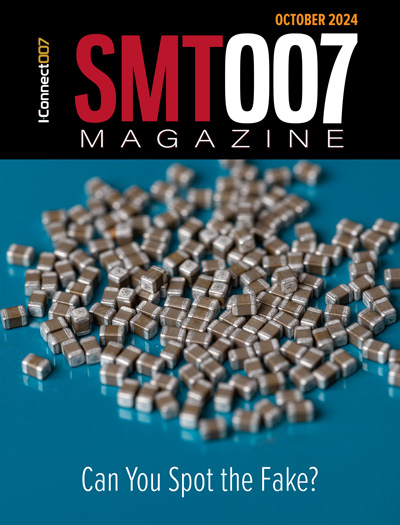-

- News
- Books
Featured Books
- smt007 Magazine
Latest Issues
Current Issue
The Rise of Data
Analytics is a given in this industry, but the threshold is changing. If you think you're too small to invest in analytics, you may need to reconsider. So how do you do analytics better? What are the new tools, and how do you get started?

Counterfeit Concerns
The distribution of counterfeit parts has become much more sophisticated in the past decade, and there's no reason to believe that trend is going to be stopping any time soon. What might crop up in the near future?

Solder Printing
In this issue, we turn a discerning eye to solder paste printing. As apertures shrink, and the requirement for multiple thicknesses of paste on the same board becomes more commonplace, consistently and accurately applying paste becomes ever more challenging.
- Articles
- Columns
Search Console
- Links
- Media kit
||| MENU - smt007 Magazine
Brookhaven Completes LSST's Digital Sensor Array
August 29, 2019 | Brookhaven National LaboratoryEstimated reading time: 6 minutes
After 16 years of dedicated planning and engineering, scientists at the U.S. Department of Energy’s (DOE) Brookhaven National Laboratory have completed a 3.2 gigapixel sensor array for the camera that will be used in the Large Synoptic Survey Telescope (LSST), a massive telescope that will observe the universe like never before.
“This is the biggest charge-coupled device (CCD) array that has ever been built,” said Paul O’Connor, senior scientist at Brookhaven Lab’s instrumentation division. “It’s three billion pixels. No telescope has ever put this many sensors into one camera.”
The digital sensor array is composed of about 200 16-megapixel sensors, divided into 21 modules called “rafts.” Each raft can function on its own, but when combined, they will view an area of sky that can fit more than 40 full moons in a single image. Researchers will stitch these images together to create a time-lapse movie of the complete visible universe accessible from Chile.
Currently under construction on a mountaintop in Chile, LSST is designed to capture the most complete images of our universe that have ever been achieved. The project to build the telescope facility and camera is a collaborative effort among more than 30 institutions from around the world, and it is primarily funded by DOE’s Office of Science and the National Science Foundation. DOE’s SLAC National Accelerator Laboratory is leading the overall effort to construct the camera—the world’s largest camera for astronomy—while Brookhaven led the design, construction, and qualification of the digital sensor array—the “digital film” for the camera.
“It’s the heart of the camera,” said Bill Wahl, science raft subsystem manager of the LSST project at Brookhaven Lab. “What we’ve done here at Brookhaven represents years of great work by many talented scientists, engineers, and technicians. Their work will lead to a collection of images that has never been seen before by anyone. It’s an exciting time for the project and for the Lab.”
Members of the LSST project team at Brookhaven Lab are shown with a prototype raft cryostat. In addition to the rafts, Brookhaven scientists designed and built the cryostats that hold and cool the rafts to -100° Celsius. Pictured from left to right are Sean Robinson, Michael Keach, Matthew Rumore, Gabriella Carini, Steven Andrade, Colleen Michael, Veljko Radeka, Wendy Morrin, Bill Wahl, Phil Kuczewski, HyeYun Park, Ivan Kotov, Andrei Nomerotski, Justine Haupt, Alfred Dellapenna, Connor Miraval, Sven Herrmann, Brian Walsh, Steve Bellavia, Paul Stankus, and Paul O'Connor. Team members not pictured include Peter Takacs, Michelle McQueen, John Kuczewski, Steve Plate, Paul Palecek, Rebecca Coles, Jason Farrell, Raj Gutta, Elliott Golnar, Anze Slozar, Don Elliott, Ron Angona, August Hoffman, David Asner, Graham Smith, and Kurt Vetter.
Page 1 of 2
Suggested Items
SIA Praises Finalization of CHIPS Investments for GlobalFoundries Manufacturing Projects
11/21/2024 | SIAThe Semiconductor Industry Association (SIA) released the following statement from SIA President and CEO John Neuffer applauding finalization of semiconductor manufacturing investments announced by the U.S. Department of Commerce and GlobalFoundries.
SIA Commends Finalization of CHIPS Incentives for TSMC
11/18/2024 | SIAThe Semiconductor Industry Association (SIA) released the following statement from SIA President and CEO John Neuffer applauding finalization of the agreement to allocate incentives to TSMC under the CHIPS and Science Act. The agreement between TSMC and the U.S. Department of Commerce will support the expansion of TSMC’s semiconductor fabs in Arizona.
iNEMI HDI Socket Warpage Prediction and Characterization Webinar
11/15/2024 | iNEMIHigh-density interconnect (HDI) sockets, primarily designed for CPUs and GPUs, are shifting toward larger form factors as the number of interconnect pins increases.
Gartner Forecasts India IT Spending to Reach $160 Billion in 2025
11/12/2024 | Gartner, Inc.India IT spending is projected to total $160 billion in 2025, an increase of 11.2% from 2024, according to the latest forecast by Gartner, Inc.
SIA Applauds CHIPS Act Incentives for Corning and Powerex
11/11/2024 | SIAThe Semiconductor Industry Association (SIA) released the following statement from SIA President and CEO John Neuffer applauding semiconductor manufacturing incentives announced by the U.S. Department of Commerce for Corning and Powerex.


